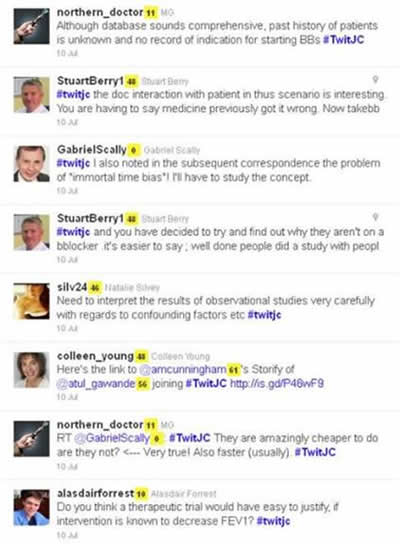Twitter Journal Club: yet another ‘revolution’ in scientific communication?
15 Jul, 11 | by BMJ
A junior doctor in the West Midlands and a medical student at Cambridge University have kicked off a new movement in the medical community by launching the first ever Twitter Journal Club. Heralded as a ‘revolution’ in scientific communication, it has enjoyed positive coverage from publishers and practitioners alike (e.g it was mentioned today at the ASME Annual Scientific Meeting). Now in its seventh week, the initiative has amassed over 950 followers on Twitter and last Sunday generated 448 tweets during a discussion of the following BMJ paper: Effect of β blockers in treatment of chronic obstructive pulmonary disease: a retrospective cohort study
So how does it all work?
Twitter Journal Club provides a place where doctors, medical students, and anyone else who is interested, can discuss publications relevant to clinical medicine. In many respects it operates in same way as any other journal club, except that the forum is Twitter.
Each week, the founders pick a medical paper which is both significant and relevant to a wide range of people. An introduction to the paper is circulated along with the main discussion points to be covered. At 8pm each Sunday the discourse between doctors, researchers, authors and students kicks off on Twitter using the relevant hashtag (#twitjc) and continues for around 2 hours. At the end of the session, a summary is circulated of the key themes that emerged during the discussion and any conclusions drawn. Anybody can join in and recommendations for future papers are openly welcomed.
Is this really ‘revolutionary’?
Some argue that this discourse is not that different from traditional scientific communication as it may seem. Journals began as letters between scientists and were only later collated and published. “The idea of the person-to-person message is the essence of communication in the sciences,” says Simon Schaffer, a historian of science at the University of Cambridge. And although many published reports were verbose, early scientists also kept notebooks in which they succinctly listed facts and observations that they had picked up from others in coffee shops and elsewhere.
When Twitter was launched five years ago scientists were among the early adopters, and many now use the microblogging platform to tweet updates from conferences, promote links to papers, network and gossip. In fact, one researcher estimates that there are 2,500 tweets per day linking to a science paper. However, using Twitter to engage in technical discussions with remote ‘colleagues’ is very much a novelty. Advocates say that Twitter enables fast-moving conversations and allows users to post (shortened) links pointing to more detail where required. An Astronomy Journal Club has already popped up in response to the medical version, and other disciplines are likely to follow suit.
For more information on how to get involved or to recommend papers to be discussed, visit https://twitjc.wordpress.com/about/
